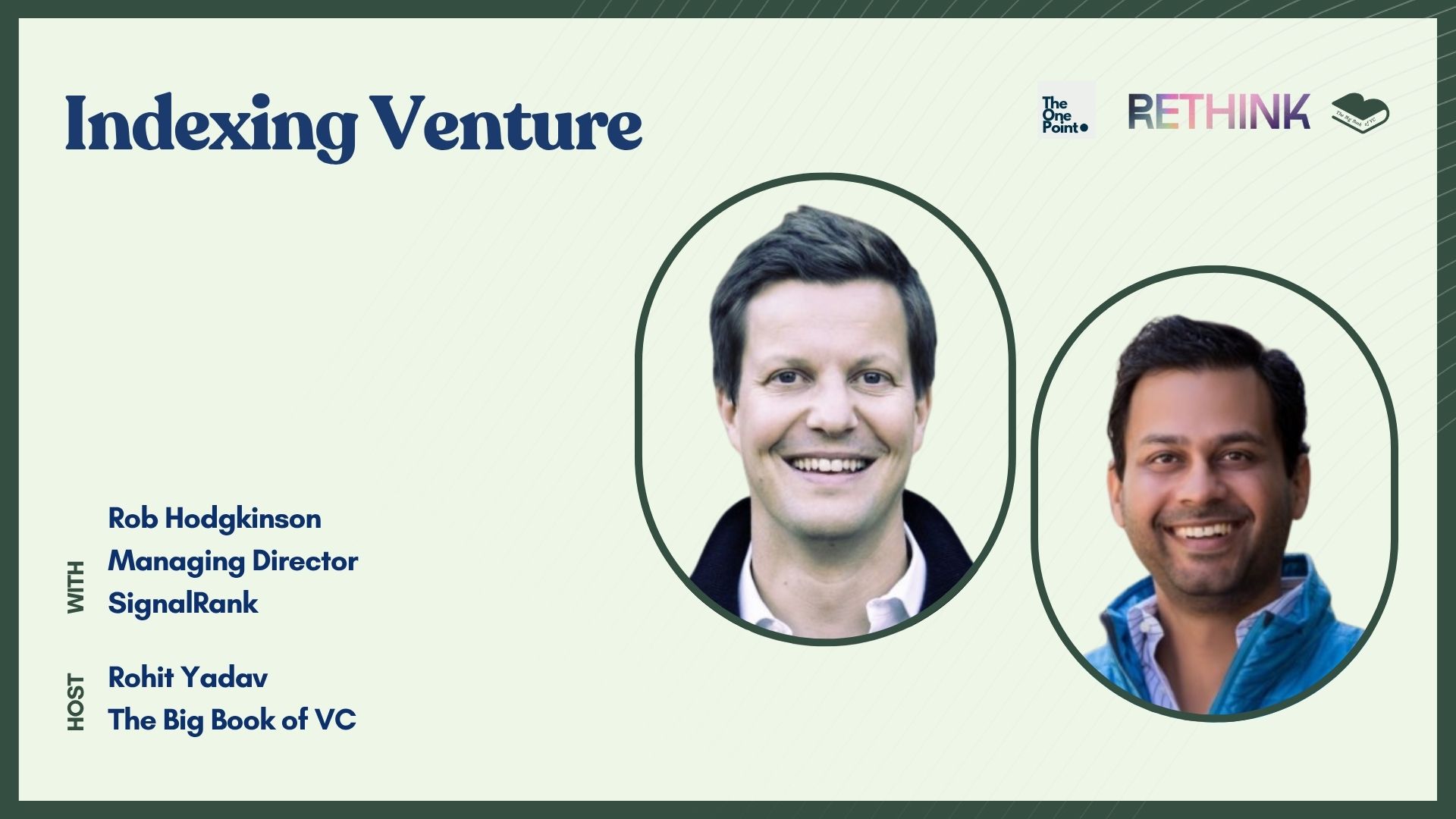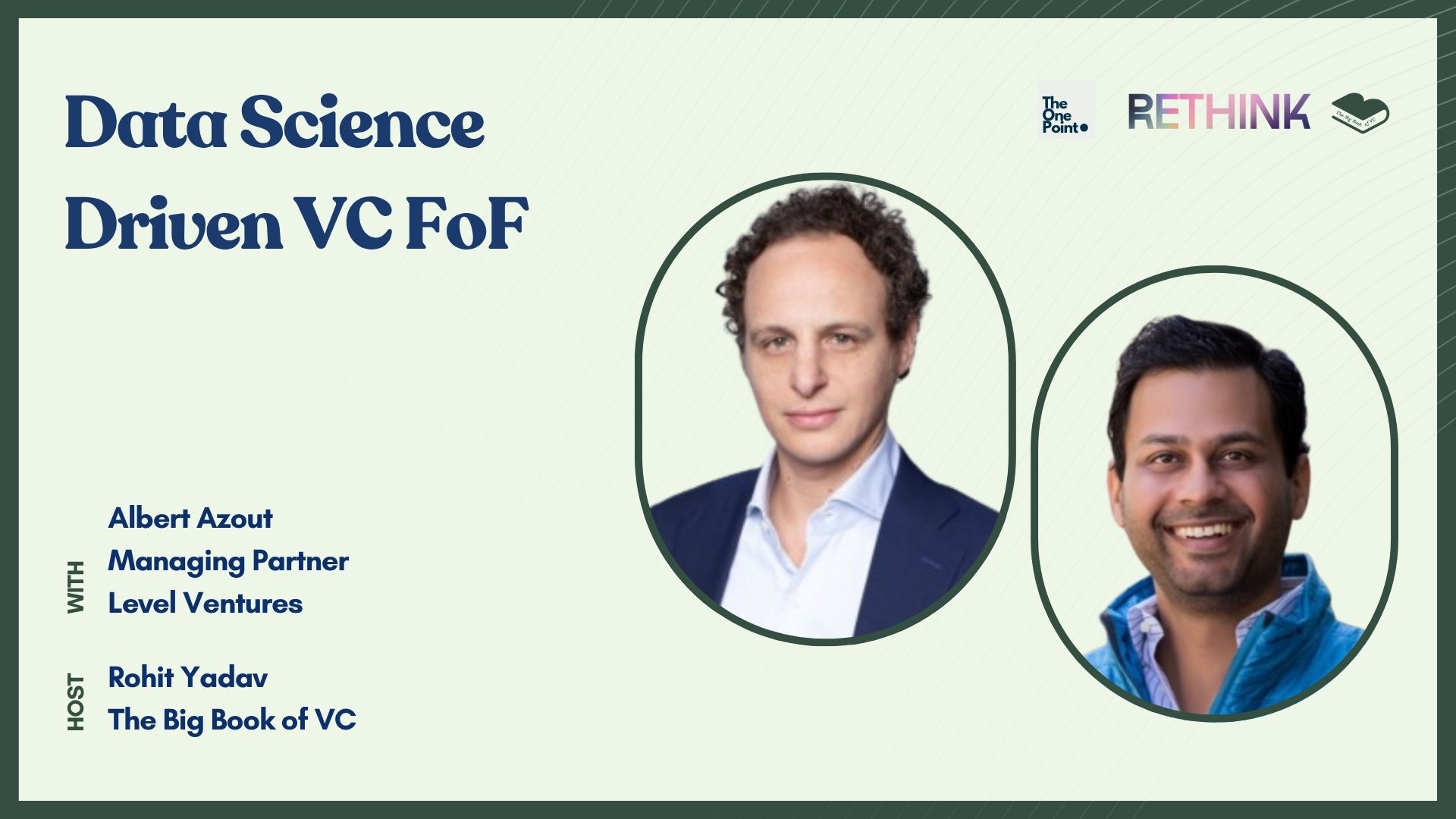Indexing Venture Capital
Snapshot of interview with Rob Hodgkinson from SignalRank
Rohit Yadav: Rob, welcome to TheOnePoint podcast. To begin, could you briefly tell us what SignalRank is?
Rob Hodgkinson: SignalRank is an index of the top 5% of Series B deals. We use a systematic, data-driven approach to identify these deals and access them through the pro rata rights of existing seed investors. Think of it as an S&P 500 for venture capital—focused on democratizing access and using data to invest.
Rohit Yadav: Interesting. So how did SignalRank come to be?
Rob Hodgkinson: I was a VC in London 10–15 years ago and found it ironic that VCs believed data would transform every industry but not their own. Back then, the data wasn’t mature enough. Later, I led a video startup, which was acquired in 2019. After moving to the U.S. in 2020, I initially tried to solve the Series B funding gap for European companies using U.S. capital. It worked but wasn’t scalable. Then I met Keith Teare, a tech veteran and founder of TechCrunch. He had built a model using data to supply pro rata capital to seed investors, and I joined him and the team in 2020.
Rohit Yadav: So your approach is fully algorithmic. What’s the basis of your model?
Rob Hodgkinson: We don’t look at company fundamentals. We focus entirely on investor patterns. We believe venture capital has persistence—top investors keep getting into top deals. So we rank investors at each stage based on unicorn creation, unicorn efficiency, and MOIC. Then we analyze patterns: what happens when top seed investors double down at Series A, or who joins in at Series B. With this method, we raise the probability of a 5x MOIC from 10% to about 30%.
Rohit Yadav: Just to clarify, even at Series B—when company data becomes richer—you’re still only using investor data?
Rob Hodgkinson: Exactly. We stand on the shoulders of giants by codifying their decisions. The strategy is unusual for venture, but not in finance. Alfred Winslow Jones, who created the first hedge fund, scored brokers based on recommendation outcomes. Europe's largest hedge fund, Marshall Wace, does something similar via their TOPS program. We're applying that concept to VC by ranking investors instead of brokers.
Rohit Yadav: PitchBook had an interesting study on network effects in VC. Do you agree with their conclusion?
Rob Hodgkinson: Absolutely. The most striking insight was that well-networked investors not only boost their upside potential but drastically reduce failure rates. Our algorithm is actually negative—it filters out the zeros. We eliminate low-quality companies, which raises the overall quality of our pool. We then sample from that pool, and our Monte Carlo simulations suggest we can 5x in five years.
Rohit Yadav: Why the exclusive focus on Series B?
Rob Hodgkinson: Four reasons. First, you can build a risk-adjusted portfolio with just ~30 investments per year. Second, the return profile is compelling—power law dynamics are still active. Third, you’re protected from post-IPO downside. In Instacart, for example, only Series B investors made money. Fourth, it’s the perfect time for seed investors to tap out and let us take over via pro rata.
Rohit Yadav: Does geography affect your model?
Rob Hodgkinson: We’re fully sector and geography agnostic. We aim to see as many Series Bs globally as possible and use the algorithm to identify the top 5%. We say no to many great companies—just because they don’t fit the pattern. Our model is high precision, low recall. So yes, we miss some unicorns, but our hit rate is strong.
Rohit Yadav: So how much of the Series B market do you actually see?
Rob Hodgkinson: We currently see about 60% of all Series Bs through a network of ~300 seed partners. Of the roughly 1,500 Series Bs annually, only about 100 qualify for our model. We see 25–30% of those. Still work to do, but we’ve proven access—we’ve made 35 investments in two years. Outside of Andreessen Horowitz, we’re the most active Series B investor globally.
Rohit Yadav: That’s huge. You recently called your fund an "index"—even though you don’t cover the full market. Why?
Rob Hodgkinson: It’s not a perfect index in a strict sense, but it’s the best metaphor. SignalRank exists to offer the kind of access LPs can’t usually get. You can't just call up Sequoia and invest. With us, you mirror their portfolios. And because we invest over time, you also get vintage diversification—something a 2-and-20 fund doesn’t offer.
Rohit Yadav: What makes you attractive to seed investors?
Rob Hodgkinson: Two things. First, we offer 20% of the carry. If we invest $1M and it 10x's, we give $1.8M to the seed partner. Second, we move fast—can close within a week. We do light diligence, focusing on term sheets and cap tables, not startup fundamentals. Most seed investors manage small funds and don’t have opportunity funds. We give them a free option to participate in later rounds without more capital.
Rohit Yadav: If it's such a great idea, why aren’t there more AI-VCs like you?
Rob Hodgkinson: Some players like Alpha Partners and Proof are in the pro rata game. But we are unique in relying 100% on the algorithm for investment decisions. That creates interesting dynamics—our own experience is irrelevant in investment calls. If we don’t trust the algorithm, why should investors?
Rohit Yadav: Outside of SignalRank, where else do you see AI impacting VC over the next year or two?
Rob Hodgkinson: At seed stage, venture is still artisanal. It’s about reading people, and I don’t see data replacing that. But at later stages, it starts to resemble public markets. Index investing dominates there, and I expect similar behavior in private markets. Only the best active managers will command higher fees; others will adopt index strategies. On tooling, areas like startup discovery, sourcing, and portfolio analytics are ripe for AI integration.
Rohit Yadav: So do you expect VCs to build these tools or use third-party platforms?
Rob Hodgkinson: It depends. The VC product is essentially a decision-making engine. If AI improves that engine, firms will invest. Some might buy tools, others will build in-house. Groups like Andre Ratterath’s data-driven VC community are really pushing the space forward and helping firms define best practices.
Rohit Yadav: Should traditional VCs be worried about AI in venture?
Rob Hodgkinson: No, not necessarily. As Mark Andreessen said, VC might be one of the last professions to be automated. The industry is fragmenting—there’s no one-size-fits-all model anymore. At early stage, the human touch still dominates. But at later stages, if you’re not using AI, you risk falling behind.
Rohit Yadav: On a personal note, how has the journey at SignalRank been for you emotionally?
Rob Hodgkinson: On the investing side, it’s been validating. The market has changed since 2021, but we’ve built in mechanisms to adjust thresholds dynamically. That helps us invest less in frothy markets and more when others are fearful. On the fundraising side, it’s been harder. We’re doing something new in a tough venture climate. But I believe democratization of access to venture is inevitable. We’re seeing financial giants like BlackRock move in that direction. We want to play a growing role in that evolution.
Rohit Yadav: Final question—what’s next for SignalRank?
Rob Hodgkinson: We’ll continue deploying capital at pace—2 to 3 Series Bs a month. The main goal is to raise more capital so we can meet average allocations of $5M per deal. We’ll also keep expanding our seed investor network. And eventually, we aim to list SignalRank, so investors can buy shares and convert MOIC to DPI anytime.
Rohit Yadav: Rob, thank you for this deeply insightful conversation. I genuinely believe your model is carving out a valuable space in the venture landscape.
Rob Hodgkinson: Thanks for having me, Rohit. Really enjoyed the chat.



.svg)




